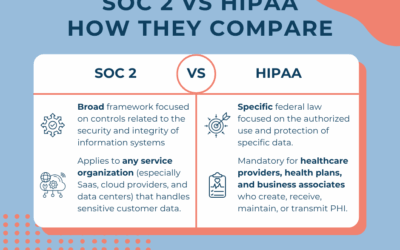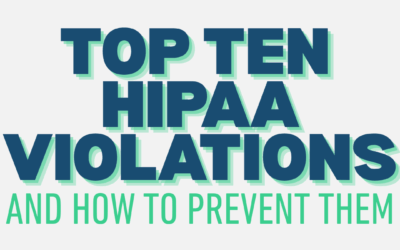In today’s interconnected world, safeguarding sensitive information is paramount, especially in healthcare. The Health Insurance Portability and Accountability Act of 1996 (HIPAA) is a federal law designed to protect an individual’s Protected Health Information (PHI), whether in physical or electronic form. For any organization operating in or near the healthcare industry, following the HIPAA Rules isn’t just a legal requirement, it builds trust and shows your clients, employees, and patients your integrity. Non-compliance can lead to severe financial penalties, reputational damage, loss of trust, and ultimately lost business opportunities. To get a foundational understanding, you can start with Total HIPAA’s comprehensive HIPAA compliance guide that answers all your questions.
Understanding HIPAA’s Core Components
Before diving into the “how-to,” it’s important to understand the basics of HIPAA. The three main Rules of HIPAA are the Privacy Rule, which sets national standards for PHI, the Security Rule, which establishes safeguards for electronic health information, and the Breach Notification Rule, which requires notification to individuals and the U.S. Department of Health and Human Services (HHS) after a breach of unsecured PHI.
- The Privacy Rule: Sets national standards for protecting individuals’ PHI by dictating permissible uses and disclosures of such information. It requires an organization to appoint a Privacy Officer, document policies and procedures, and grant individuals rights to access and correct their health information.
- The Security Rule: Specifically addresses the protection of electronic PHI (ePHI). It mandates the implementation of Administrative, Physical, and Technical Safeguards to ensure the confidentiality, integrity, and availability of ePHI.
- The HITECH Act: Significantly expanded HIPAA by solidifying fines and penalties for violations, and introducing structured breach notification rules. Importantly, HITECH extended HIPAA compliance standards to Business Associates and Business Associate Subcontractors.
- The Breach Notification Rule: Introduced with HITECH, requires Covered Entities and Business Associates to notify individuals whose PHI has been compromised, HHS, and, in certain cases, the media, following a breach of unsecured PHI.
- The Omnibus Ruling: This Rule clarified ambiguities in HITECH and removed the “Harm Standard,” meaning any unauthorized release of PHI in an unsecured format is presumed to be a breach. It also established civil penalties for individuals violating HIPAA.
Steps to Achieve and Maintain HIPAA Compliance
Becoming HIPAA compliant is an ongoing process, not a one-time event. and requires a systematic approach. Follow these steps to achieve HIPAA compliance:
1. Conduct a Comprehensive Risk Assessment
The cornerstone of any robust HIPAA compliance program is a comprehensive Risk Assessment (RA). This is the foundational step, identifying potential vulnerabilities to the confidentiality, integrity, and security of PHI within your organization. To understand the importance of the RA, consider this step a blueprint for all your compliance activities. It should be reviewed annually or when significant changes occur (change in systems, upgrades to devices, new hires with access to PHI, etc.). Total HIPAA offers a comprehensive RA tool with automated annual reminders, as well as expert guidance and clarification to ensure your organization isn’t left to navigate this crucial process alone. Book a demo here!
2. Develop and Implement Robust Policies and Procedures
Based on the completed RA, detailed documents for Privacy, Security, and Breach Notification, need to be created that are tailored to your organization’s specific practices. These policies should cover everything from data handling to IT security measures, and must be regularly reviewed and updated. A generic template will not suffice; these policies and procedures must be tailored to your organization!
3. Implement Necessary Safeguards
Third, apply the Administrative, Physical, and Technical Safeguards detailed in the HIPAA Security Rule.
- Administrative Safeguards involve documented activities such as designating a Privacy and Security Officer, conducting regular risk assessments, training staff, and developing a disaster recovery plan.
- Physical Safeguards regulate how physical systems and equipment containing PHI are handled, detailing secure locations, physical security, and access logs.
- Technical Safeguards outline IT-related security practices like unique user logins, automatic system timeouts, multi-factor authentication (MFA), anti-malware software, encryption of data (at rest, in transit, in storage), and password protection for devices.
4. Appoint Compliance Officers
A key to successful implementation is to designate a Privacy Officer (PO) and an Information Security Officer (ISO). In smaller organizations, this can be the same person. They are primarily responsible for overseeing HIPAA compliance efforts, enforcing policies, and serving as points of contact for inquiries and concerns.
5. Provide Mandatory Employee Training and Awareness
All workforce members who come into contact with PHI, including contractors, must receive training upon hiring (typically within 30 days or before they have any access to PHI) and annually thereafter. Training should cover what PHI is, why it must be protected, the organization’s specific policies and procedures, and how to report incidents. All training must be meticulously documented and records kept for 6 years. If there is a breach, these training records will be part of the HHS investigation. For a simplified, all-in-one approach to compliance, Total HIPAA provides comprehensive solutions, including annual training and maintaining training records
6. Manage Business Associate Agreements (BAAs)
Your organization must have signed BAA with every third-party vendor or subcontractor that accesses, creates, maintains, or transmits PHI on the organization’s behalf. These Agreements are critical for defining responsibilities, permitted uses of PHI, and breach notification obligations. Plus, HHS will request these Agreements as part of any breach investigation.
7. Establish an Incident Response and Breach Notification Plan
Having a clear plan in place for addressing potential PHI breaches is crucial. This includes internal reporting procedures, assessment protocols to understand the breach’s impact, and processes for notifying affected individuals and federal agencies within the required timeframes.
8. Conduct Regular Monitoring and Updates
Beyond initial compliance, continuous monitoring and updates are essential. This involves regular checks to ensure policies are followed, identifying new vulnerabilities, and adapting to changes in technology or regulations.
9. Maintain Meticulous Documentation
All HIPAA compliance efforts, including RAs, policies, training records, BAAs, and audit logs, must be documented and retained for at least six years. This documentation is crucial for demonstrating adherence during an audit or investigation.
The Importance of a Culture of Compliance
Beyond policies and procedures, fostering a “culture of compliance” is vital. This means leaders demonstrate a strong commitment to data security and encourage the workforce to value it. They should feel empowered to report suspicious incidents without fear of blame, know the process, and to whom to report and incidents. An “avoidance culture,” where HIPAA is seen as an unnecessary burden, significantly increases vulnerability to hacks and the severity of consequences if a breach occurs.
Understanding the Penalties for Non-Compliance
Violating HIPAA can result in severe repercussions. Penalties vary based on the nature and culpability of the violation:
- Financial Fines: These can range from $100 per violation to millions of dollars annually, depending on factors like whether the organization knew of the violation, had reasonable cause, or was willfully negligent.
- Criminal Penalties: Personnel directly responsible for violations may face criminal penalties and even prison sentences.
- Hidden Costs: Beyond direct fines, breaches incur significant hidden costs, including loss of business, erosion of employee and client trust, legal fees, and the expense of client protection services like credit monitoring.
Learn more about the consequences of noncompliance here.
Leveraging Technology and Expertise
Navigating HIPAA compliance can be complex, posing a challenge for organizations of all sizes, from growing startups to large-scale enterprises. Fortunately, Total HIPAA offers compliance tools and expert services to significantly simplify the process. We help streamline risk assessments, documentation, employee training, and regulatory updates, making compliance more manageable. We provide expert guidance, ongoing support and unparalleled assistance from initial implementation, to maintaining year-after-year compliance, and unlimited Breach and Audit support. Schedule a call to learn more about how we can help your organization meet HIPAA standards.
An Ongoing Journey
HIPAA compliance is not a static destination but a continuous journey that evolves with your organization and the changes in technology. By diligently following these steps, fostering a culture of compliance, and leveraging Total HIPAA’s tools and expertise, organizations can protect sensitive information, build invaluable trust, and navigate this complex regulatory environment with confidence.
Sources
- U.S. Department of Health & Human Services (HHS). “Summary of the HIPAA Privacy Rule.” https://www.hhs.gov/hipaa/for-professionals/privacy/laws-regulations/index.html
- U.S. Department of Health & Human Services (HHS). “Summary of the HIPAA Security Rule.” https://www.hhs.gov/hipaa/for-professionals/security/laws-regulations/index.html
- U.S. Department of Health & Human Services (HHS). “Summary of the HIPAA Breach Notification Rule.” https://www.hhs.gov/hipaa/for-professionals/breach-notification/index.html
- U.S. Department of Health & Human Services (HHS). “Modifications to the HIPAA Rules.” https://www.hhs.gov/hipaa/for-professionals/privacy/laws-regulations/combined-regulation/index.html
- U.S. Department of Health & Human Services (HHS). “Guidance on Risk Analysis.” https://www.hhs.gov/hipaa/for-professionals/security/guidance/guidance-risk-analysis/index.html



